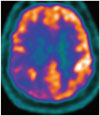Dear Editor,
Alien hand syndrome (AHS) is a sensation of foreignness between the patient and one of his or her hands, where the affected hand is observed to perform autonomic purposive behaviors that are interpreted as spontaneous movements of the limb that have an alien origin.1 Recent studies have found that anatomical lesions leading to uncontrolled limb movement and a feeling of estrangement were predominantly located in the corpus callosum and/or supplementary motor area.2 In contrast to the well-known sequelae of anterior frontocallosal lesions, posterior AHS is a very rare clinical condition, and the pathophysiology underlying this phenomenon is still unclear.2 Object affordance theory suggest the role of the right parietal area and its connections with other areas in regulating object affordance primed by the environment. This theory further shows that exaggerated object affordance effects may lead to abnormal hand behaviors in AHS that are related to the balance of objectevoked automatic motor activation and the suppression of these automatically evoked responses.3
Here we describe a 63-year-old right-handed male patient who was presented with spontaneous movements and estrangement of the left hand. A neurological examination revealed mild hemiparesis and extensor plantar responses on the left side. Involuntary movements of the left upper limb, predominantly of the wrist and the hand, were prominent. The patient did not feel when the extravolitional activity was initiating, and was not able control the behavior of the hand, describing this action as if someone else was controlling the arm from outside." The findings of a neuropsychological examination were normal except for left-side hemineglect and visuoconstructive impairment shown on tests of spontaneous drawing or copying.
In the light of previous findings suggesting the significant role of the corpus callosum and frontal lobe in anterior AHS, we aimed to show that the metabolic impairment does not extend to the well-known anterior brain regions through diachysis. As opposed to frontal and callosal cases of alien hand, in which ipsilateral motor plans and callosal transfer to the opposite hemisphere are regulated abnormally, our patient had a complicated sensory disorder with self-stimulation from the neglected side. In addition to MRI indicating a right-side hemorrhagically transformed ischemic area, FDG-PET scanning revealed significantly reduced glucose uptake in the right parietotemporal cortical region compared to the contralateral hemispheric region (more than 2 standard deviations below the mean of the asymptomatic control group; version 3.5, NeuroQ, Syntermed, Atlanta, GA, USA) (Fig. 1), with this difference being most pronounced in the sensorimotor area.
Based on a recent report,4 the present case is exceptional in showing that an isolated cerebrovascular lesion located structurally and metabolically purely in the posterior region can lead to AHS. The present findings indicate that due to the rare presentation of the posterior subtype of AHS and the often-transient nature of the symptoms, functional neuroimaging combined with stimulus-based neuropsychological tasks might provide more information than a subjective radiological evaluation limited to MRI. Moreover, this case demonstrates that single case reports may help us to deepen our understanding of the pathophysiology of AHS.
Figures and Tables
Fig. 1
A hemorrhagically transformed ischemic area is evident in axial T1-weighted MRI, and significant hypometabolism in the right-side parietotemporal cortical area is revealed by FDG-PET. The raw FDG-PET data were processed using NeuroQ software (version 3.5, Syntermed), and the average pixel values in standardized regions of interest were calculated automatically. Areas and whole-brain ratios were compared to normal values in a database.

References
1. Goldberg G, Bloom KK. The alien hand sign. Localization, lateralization and recovery. Am J Phys Med Rehabil. 1990; 69:228–238.
2. Kloesel B, Czarnecki K, Muir JJ, Keller AS. Sequelae of a left-sided parietal stroke: posterior alien hand syndrome. Neurocase. 2010; 16:488–493.





 PDF
PDF ePub
ePub Citation
Citation Print
Print


 XML Download
XML Download